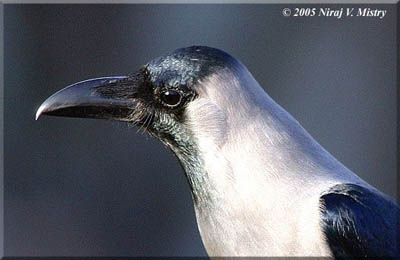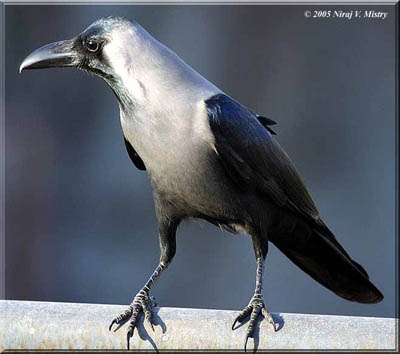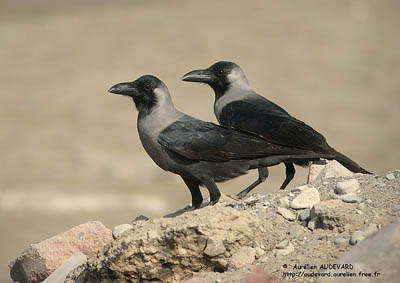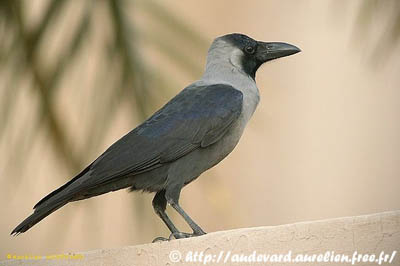
House Crow
Corvus splendens
Passeriforme Order – Corvidae Family
BIOMETRICS:
Length: 41-43 cm
Wingspan: 76-85 cm
Weight: 320-415 g
DESCRIPTION:
House Crow is a slender, blackish medium-sized crow, with long bill.
Head, nape and breast sides are greyish, contrasting with the black body plumage. Forehead, chin and throat are black. Underparts are paler grey. The black bill is longer than in other crows. Eyes are brown. Long legs and feet are black.
DIET:
House Crow is omnivorous. It feeds on rubbish, left-overs, debris, and in sewage. It also consumes lizards, fish, frogs, insects, crabs, nectar, fruits and cereal seeds, but chicks, eggs and small mammals too.
PROTECTION / THREATS / STATUS:
House Crow populations are not threatened. In some locations, the vultures’ population decline reduces food-competition and is to House Crow’s advantage.
Fr : Corbeau familier
All : Glanzkrähe
Esp : Cuervo Casero
Ital : Cornacchia grigia indiana
Nd : Huiskraai
Russe : Индийская домовая ворона
Sd: Huskråka
Photographers:
Niraj V. Mistry
His website: Photo Galleries
Aurélien Audevard
His website: OUESSANT DIGISCOPING
Text by Nicole Bouglouan
Sources:
BIRDS OF THE MIDDLE EAST by R.F. Porter, S. Christensen, P Schiermacker-Ansen C.Helm - ISBN: 0713670169
GUIDE HEINZEL des Oiseaux d’Europe de Hermann Heinzel, Richard Fitter et John Parslow – Delachaux et Niestlé – ISBN : 2603014862
Wikipedia (Wikipedia, The Free Encyclopedia)

Both sexes are similar.
Juvenile is slightly darker, with darker grey areas and duller black plumage than in adults.
VOICE: SOUNDS BY XENO-CANTO
House Crow is very vocal. It often calls while flying, a typical monotonous, rather dry “kaaa-kaaa-kaaa”. But it also may utter numerous articulated and expressive notes.
HABITAT:
House Crow is often seen near towns and villages, mainly with harbour. It needs some trees too.
This species is common in mangroves, coconut groves and plantations, particularly banyan trees.
RANGE:
House Crow has certainly been introduced by boats coming from Southern Asia. It is found in India, Nepal and Bangladesh.

BEHAVIOUR:
House Crow is well named. It is very sociable and noisy once established. This species lives near humans, cleaning streets and gardens, and perching on roofs, pylons and others poles.
It feeds mainly on the ground, but also in trees or buildings. It is often seen near rubbish, slaughter-houses, markets and farmlands, beaches close to fisheries or near touristic complexes. It can travel more than 15 km for feeding.
House Crow is sedentary.
When giving its typical call « kwaa », it is perched with head held forwards, fluffed throat feathers and dropped tail.
During the breeding season, it is seen in pairs, but it usually lives in groups of up to 50 birds. It may become aggressive against raptors.
Courtship displays consist of mutual preening and bill-rubbing, occasionally followed by rapid copulation. This behaviour occurs in trees.

FLIGHT:
When in flight, we can see easily the long tail and the slender wings of the House Crow. It appears entirely dark, because the contrast between grey and black is difficult to see.
REPRODUCTION:
House Crow’s nest is always situated near habitations, in fork close to a tall tree-top, or on outer branches, often in banyan or mango trees.
Female builds the nest. It is a coarse nest, often made with thorny twigs, plastic, string, some pieces of metal, electric wires…
The depression in the centre is lined with wood fibres or bark pieces, grasses, hair, rags, and other soft materials. Sometimes, the interior is unlined.
Female lays 3-5 eggs, of variable size and colour. They usually are pear-shaped and glossy, blue or pale green, with brown or grey speckles, spots and streaks.
Incubation lasts about 15-17 days, by both parents, but mainly by female at night. Chicks remain at nest about 21 to 28 days, raised by both adults. They are dependent on parents during several weeks after leaving the nest.
